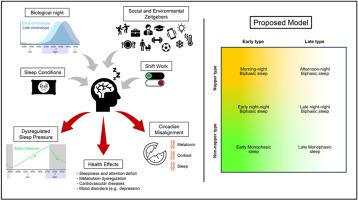Biphasic sleep and human health: A theoretical paradigm for personalized sleep
IF 3.4
2区 医学
Q1 CLINICAL NEUROLOGY
引用次数: 0
Abstract
As our understanding of sleep evolves, a recurring recommendation remains that adults should sleep in a single, uninterrupted nocturnal bout – commonly referred to as monophasic sleep. However, the scientific foundation for this standard may be less canonical than previously assumed, particularly when considering individual variability in sleep needs and organization. Historical texts and recent research suggest an alternative view: that sleep can be naturally segmented into two periods across the 24h cycle – a pattern known as biphasic sleep. This review explores the physiological implications of biphasic sleep, examining its potential benefits and limitations under healthy conditions and in particular contexts, such as shift working. With this available data, an original hypothesis is proposed, consisting of a novel framework of sleep distribution according to sleeping types. This aims to stimulate new research about biphasic schedules and how sleep architecture might adapt to them over time. The strengths and weaknesses of existing research will be critically assessed, culminating in recommendations for future investigations and methodological approaches. These insights may ultimately inform more personalized and flexible sleep guidelines better aligned with individual and societal needs.

双相睡眠与人类健康:个性化睡眠的理论范式
随着我们对睡眠的理解不断发展,一个反复出现的建议仍然是成年人应该在夜间进行一次不间断的睡眠——通常被称为单相睡眠。然而,这一标准的科学基础可能没有之前假设的那么规范,特别是考虑到个体在睡眠需求和组织方面的差异。历史文献和最近的研究提出了另一种观点:睡眠可以自然地分为24小时周期中的两个阶段——这种模式被称为双相睡眠。这篇综述探讨了双相睡眠的生理意义,研究了它在健康条件下和轮班工作等特定环境下的潜在益处和局限性。在此基础上,作者提出了一个基于睡眠类型的睡眠分布新框架的假设。这项研究的目的是激发关于双相作息的新研究,以及睡眠结构如何随着时间的推移而适应它们。将对现有研究的优点和缺点进行严格评估,最后对今后的调查和方法方法提出建议。这些见解可能最终会提供更个性化、更灵活的睡眠指南,更好地符合个人和社会需求。
本文章由计算机程序翻译,如有差异,请以英文原文为准。
求助全文
约1分钟内获得全文
求助全文
来源期刊

Sleep medicine
医学-临床神经学
CiteScore
8.40
自引率
6.20%
发文量
1060
审稿时长
49 days
期刊介绍:
Sleep Medicine aims to be a journal no one involved in clinical sleep medicine can do without.
A journal primarily focussing on the human aspects of sleep, integrating the various disciplines that are involved in sleep medicine: neurology, clinical neurophysiology, internal medicine (particularly pulmonology and cardiology), psychology, psychiatry, sleep technology, pediatrics, neurosurgery, otorhinolaryngology, and dentistry.
The journal publishes the following types of articles: Reviews (also intended as a way to bridge the gap between basic sleep research and clinical relevance); Original Research Articles; Full-length articles; Brief communications; Controversies; Case reports; Letters to the Editor; Journal search and commentaries; Book reviews; Meeting announcements; Listing of relevant organisations plus web sites.
 求助内容:
求助内容: 应助结果提醒方式:
应助结果提醒方式:


